Alexika HBC 5 basic – страница 2
Инструкция к Alexika HBC 5 basic
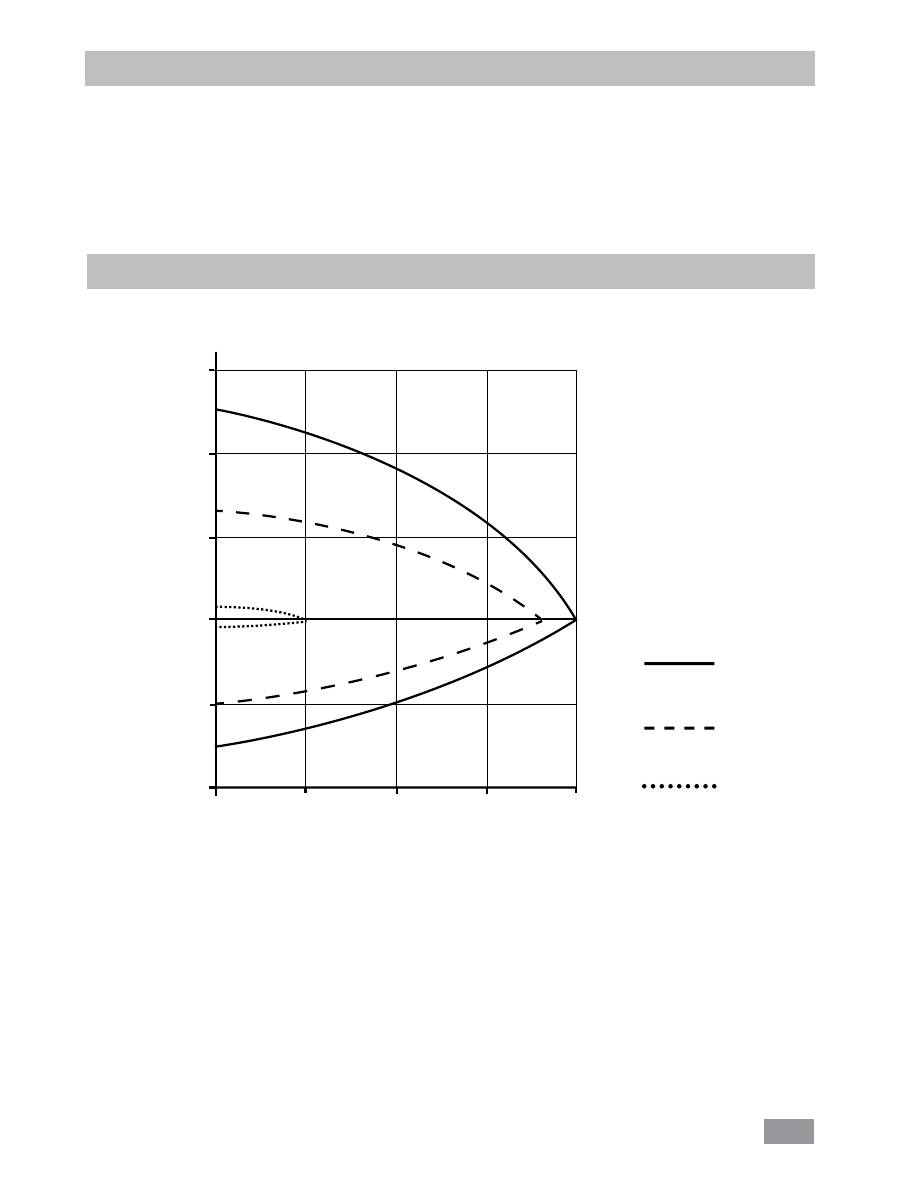
21
Pumpenkennlinie
Gewährleistung
Entsprechend den
IKA
®
-Verkaufs- und Lieferbedingungen
beträgt die Gewährleistungzeit 24 Monate. Im Gewährleis-
tungsfall wenden Sie sich bitte an Ihren Fachhändler. Sie
können aber auch das Gerät unter Beifügung der Liefer-
rechnung und Nennung der Reklamationsgründe direkt an
unser Werk senden. Frachtkosten gehen zu Ihren Lasten.
Die Gewährleistung erstreckt sich nicht auf Verschleißteile
und gilt nicht für Fehler, die auf unsachgemäße Handha-
bung und unzureichende Pflege und Wartung, entgegen
den Anweisungen in dieser Betriebsanleitung, zurückzufüh-
ren sind.
Pumpenkennlinie gemessen mit Wasser
0,6 0,4 0,2 0,0 -0,2 -0,4 0 5 10 15 20 Q [l/min] P [bar]
4000 rpm
3000 rpm
1000 rpm
Fig. 18

22
Contents
EN
Source language: German
Page
EC Declaration of Conformity ..................................................................................................................23
Explication of warning symbols ..............................................................................................................23
Safety instructions ..................................................................................................................................24
General information ....................................................................................................................................... 24
Fluids ............................................................................................................................................................. 25
Correct use ..............................................................................................................................................25
Use ................................................................................................................................................................ 25
Range of use (indoor use only) ....................................................................................................................... 25
Unpacking ...............................................................................................................................................26
Unpacking ..................................................................................................................................................... 26
Delivery scope ................................................................................................................................................ 26
Preparations ............................................................................................................................................26
Setting up ...................................................................................................................................................... 26
Connecting the tubings .................................................................................................................................. 26
Filling and draining ......................................................................................................................................... 27
Fluids ............................................................................................................................................................. 27
Cooling coil .................................................................................................................................................... 28
Operator panel and display .....................................................................................................................28
Commissioning ........................................................................................................................................29
Setting the safety temperature ...............................................................................................................29
Menu settings .........................................................................................................................................30
Menu structure .............................................................................................................................................. 30
Basic guide to setting the menu options ......................................................................................................... 30
Operating mode (MODE)................................................................................................................................ 30
Maximum temperature (HI T) ......................................................................................................................... 30
Minimum temperature (LO T) ......................................................................................................................... 30
Maximum speed (HI R) ................................................................................................................................... 30
Minimum speed (LO R) ................................................................................................................................... 31
Fluid type (FLUI) ............................................................................................................................................. 31
The type of temperature PID control arithmetic (AUTO) .................................................................................. 31
External and internal temperature control (ET) ................................................................................................ 32
Alarm and key tone (BEEP) ............................................................................................................................. 32
Calibration (CALI) ........................................................................................................................................... 32
Interface and output ...............................................................................................................................33
Maintenance and cleaning ......................................................................................................................35
Error codes ..............................................................................................................................................36
Accessories ..............................................................................................................................................37
Technical data .........................................................................................................................................38
Warranty .................................................................................................................................................39
Pump performance curve ........................................................................................................................39

23
EC Declaration of Conformity
Explication of warning symbols
DANGER
General hazard
This symbol identifies information
that is of vital importance for protecting your health
and safety
. Disregarding this information may lead to health impairment and injuries.
This symbol identifies information
that is of importance for the technically correct func-
tioning of the system
. Disregarding this information may result in damage to the device or
to system components.
This symbol indicates information
which is important for proper use and ensuring that
the operations of the device are performed efficiently and for using the device
.
Fail-
ure to observe this information may result in inaccurate results.
Danger
- Reference to exposure to a hot surface!
Hot surface!
DANGER
CAUTION
WARNING
We declare under our sole responsibility that this product corresponds to the regulations 2006/95/EC, 2004/108/
EC and 2011/65/EU and conforms with the standards or standardized documents: EN 61010-1, -2-010, -2-051; EN
61326-1 and DIN 12876-1.
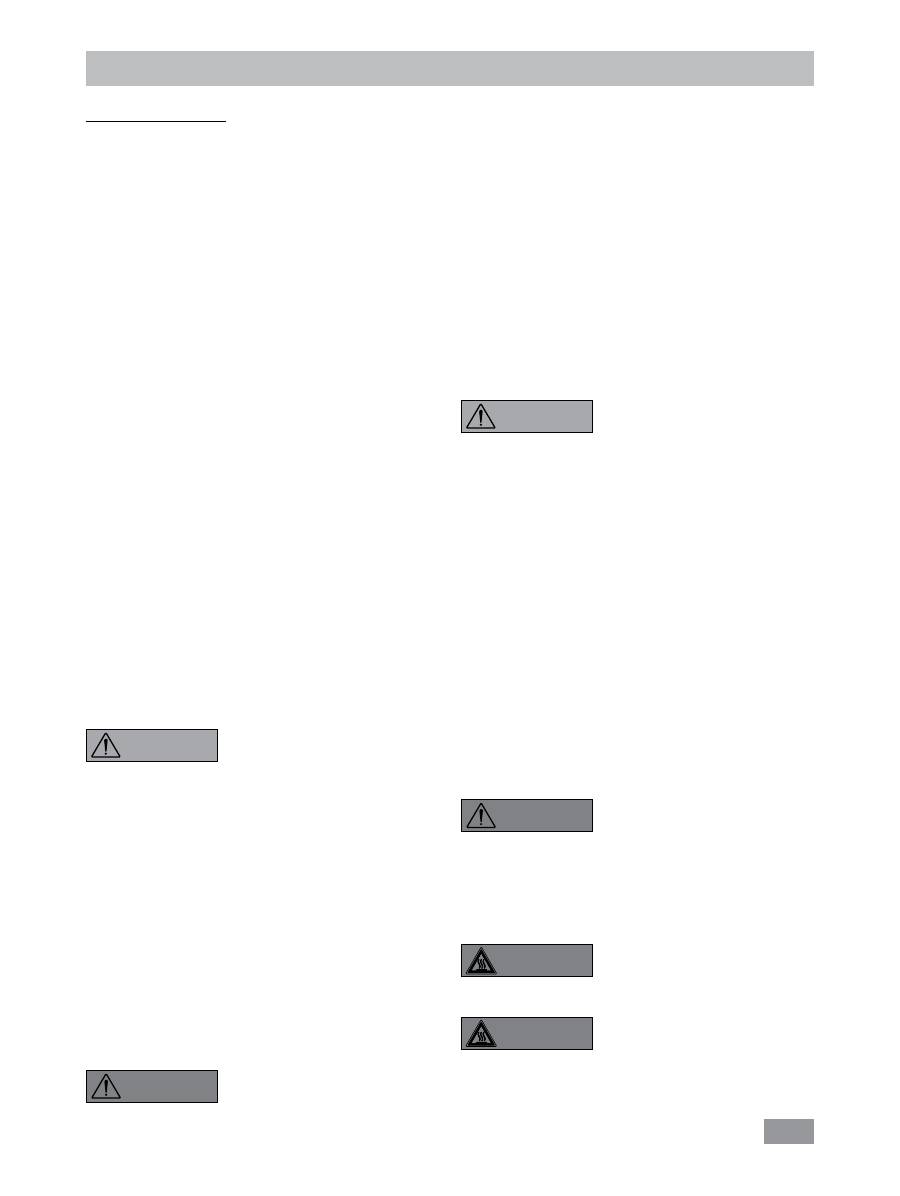
24
Safety instructions
General information
•
Read the operating instructions completely before
starting up and follow the safety instructions.
• Keep the operating instructions in a place where it can be
accessed by everyone.
• Ensure that only trained staff work with the device.
• Follow the safety instructions, guidelines, occupational
health, safety and accident prevention regulations.
• Set up the device in a spacious area on an even, stable,
clean, non-slip, dry and fireproof surface.
• Do not operate the device in explosive atmospheres,
with hazardous substances.
• Protect the device and accessories from bumping and
impacting.
• Check the device and accessories for damage before
each use. Do not use damaged components.
• Safe operation is only guaranteed with the accessories
described in the ”
Accessories
” section.
• The socket for the mains cord must be easily accessible.
• Socket must be earthed (protective ground contact).
• The voltage stated on the type plate must correspond to
the mains voltage.
• The device can only be disconnected from the mains sup
-
ply by pulling out the mains plug or the connector plug.
• Disconnect the mains plug before attaching or changing
any accessories.
• Disconnect the mains plug before cleaning, mainte
-
nance or moving the circulator.
•
The device must only be opened by trained specialists,
even during repair. The device must be unplugged from
the power supply before opening. Live parts inside the
device may still be live for some time after unplugging
from the power supply.
Coverings or parts that can be re-
moved from the device without
the aid of any tools must be put
back on the device again to ensure safe operation, for
example to keep foreign objects and liquids, etc. from
getting into the device.
• The device may only be used as prescribed and as de
-
scribed in the operating instructions. This includes op-
eration by instructed specialist personnel.
• When using critical or hazardous materials in your pro
-
cesses,
IKA
®
recommends to use additional appropri-
ate measures to ensure safety in the experiment. For
example, users can implement measures that inhibit fire
or explosions or comprehensive monitoring equipment.
• Process pathogenic material only in closed vessels under
a suitable fume hood. Please contact
IKA
®
application
support if you have any question.
If the
OFF
switch is not within
reach when device is operating, an
EMERGENCY STOP
switch that
can be easily accessed must be installed in the work area.
• A laboratory circulator heats and circulates fluid accord
-
ing to specified parameters. This involves hazards due to
high temperatures, fire and general hazards due to the
device of electrical energy. The user is largely protect-
ed by the device of relevant standards. Further hazard
sources may arise due to the type of tempering fluid,
e.g. by exceeding or undercutting certain temperature
thresholds or by the breakage of the container and re-
action with the heat carrier fluid. It is not possible to
consider all eventualities. They remain largely subject to
the judgment and responsibility of the operator. For this
reason, it may become necessary for user to take other
precautionary safety measures.
• Insufficient ventilation may result in the formation of explo
-
sive mixtures. Only use the device in well ventilated areas.
The safety circuit (safe tempera-
ture) must be adjusted so that the
maximum permissible temperature
cannot be exceeded even in the event of a fault. Check
the safe temperature circuit on a regular basis (see sec-
tion "
Setting the safety temperature
").
• Securely fix the
IC basic
immersion circulator for use at
the bath, so that it cannot tip over.
• Use suitable hoses for connection.
• Secure hoses and tubes against slippage and avoid
kinks.
• Check hoses, tubes and bath at regular intervals for pos
-
sible material fatigue (cracks/leaks).
• When device is used for external circulation, extra pre
-
caution must be taken for hot liquid leakage due to
damaged hose.
• Mains cable should not get in contact with hot parts
and fluids.
• If you are using plastic bath, observe the permitted
working temperature range and fluids.
Do not start up the device if:
- It is damaged or leaking
- Cable (not only supply cable) is damaged.
• Be careful when filling a hot bath.
At high operating temperatures, the
temperature of housing parts, sur-
faces and tubes can exceed 70 ° C.
It is dangerous to touch the heater.
The temperature of the heater can
be very high.
DANGER
DANGER
WARNING
DANGER
WARNING
DANGER
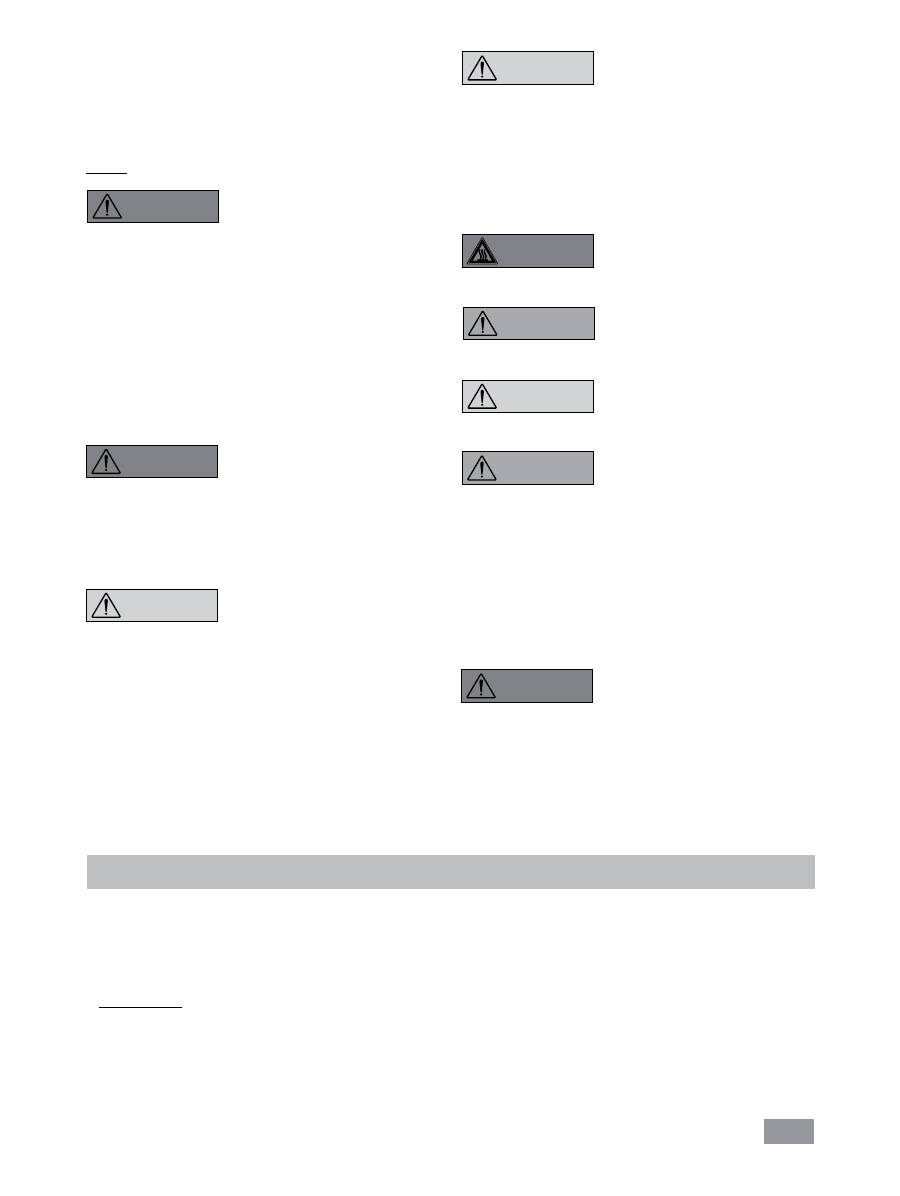
25
• After a power failure during operation, the device may
start automatically (depending on operating mode).
• Transport the device with care.
• Do not transport or empty the bath while it is still hot.
This may result in accidents, especially scalding injuries.
Fluids
Only
use fluids, which fulfill the re
-
quirements for safety, health and
device compatibility. Be aware of
the chemical hazards that may be associated with the
bath fluid used. Observe all safety warnings for the fluids.
• Depending on the bath fluid used and the type of opera
-
tion, toxic or flammable vapors can arise. Ensure suit
-
able extraction.
• Do not use any fluid which may cause dangerous reac
-
tions during processing.
• Only use recommended bath fluid. Only use non-acid
and non corroding fluid.
Only process and heat up any fluid
that has a flash point higher than
the adjusted safe temperature limit
that has been set. The safe temperature limit must al-
ways be set to at least 25 ºC lower than the flash point
of the fluid used. Examine regularly the function of the
safety temperature limiter.
Never operate the device without
sufficient heat carrier fluid! You
should also be careful to ensure
that the minimum clearances and immersion depths in
the fluid are observed. Check the fluid level detection at
a regular basis (see the chapter "
Filling and draining
").
• Continuous monitoring of the bath and the filling level of
the bath fluid is required, especially at high temperatures.
• For optimum temperature stability, the fluids viscosity
should be 50 mm
2
/s or less at its lowest operating tem-
perature. This permits good fluid circulation and mini
-
mizes heating from the pump.
If water is used at higher tempera-
ture, there is heavy loss of fluid due
to the condensation of evapora-
tion steam.
• Untreated tap water is not recommended. It is recom
-
mended to use distilled water or high purity water (ion
exchangers) and add 0,1 g soda (sodium carbonate
Na
2
CO
3
) /liter, to reduce corrosive properties.
Risk of burning caused by vapor or
hot water at the outlet of the cool-
ing coil.
Do not use the cooling coil with
water at bath temperatures > 95°
C.
For bath temperatures > 60°C make
sure that the flow rate through the
cooling coil is high enough.
Don't use following fluids:
- Untreated tap water
- Concentration of acids or bases
- Solutions with halides: chlorides, fluorides, bromides,
iodides or sulfur
- Bleach (Sodium Hypochlorite)
- Solution with chromates or chromium salts
- Glycerine
- Ferrous water.
When changing the bath fluid
from water to a heat transfer fluid
for temperatures above 100 °C, re-
move the remaining water from the complete system
(including hoses and external devices). When doing this,
also open the stopper and union nuts caps of the pump
outputs and inputs and blow compressed air through
all the pump outputs and inputs! Beware of the risk of
burning due to delay in boiling!
CAUTION
DANGER
WARNING
DANGER
CAUTION
DANGER
DANGER
CAUTION
WARNING
Correct use
• Use
Use
IC
(
I
mmersion
C
irculator) and
HBC
(
H
eating
B
ath
C
irculator)
- For heating and circulating fluids
Intended Use: Tabletop Device
• Range of use (indoor use only)
- Laboratories
- Schools
- Pharmacies
- Universities
This device is suitable for use in all areas except:
- Residential areas
- Areas that are connected directly to a low-voltage supply
network that also supplies residential areas.
The safety of the user cannot be guaranteed:
- If the device is operated with accessories that are not
supplied or recommended by the
IKA
®
.
- If the device is operated improperly or in contrary to the
IKA
®
specifications.
- If the device or the printed circuit board are modified by
third parties.
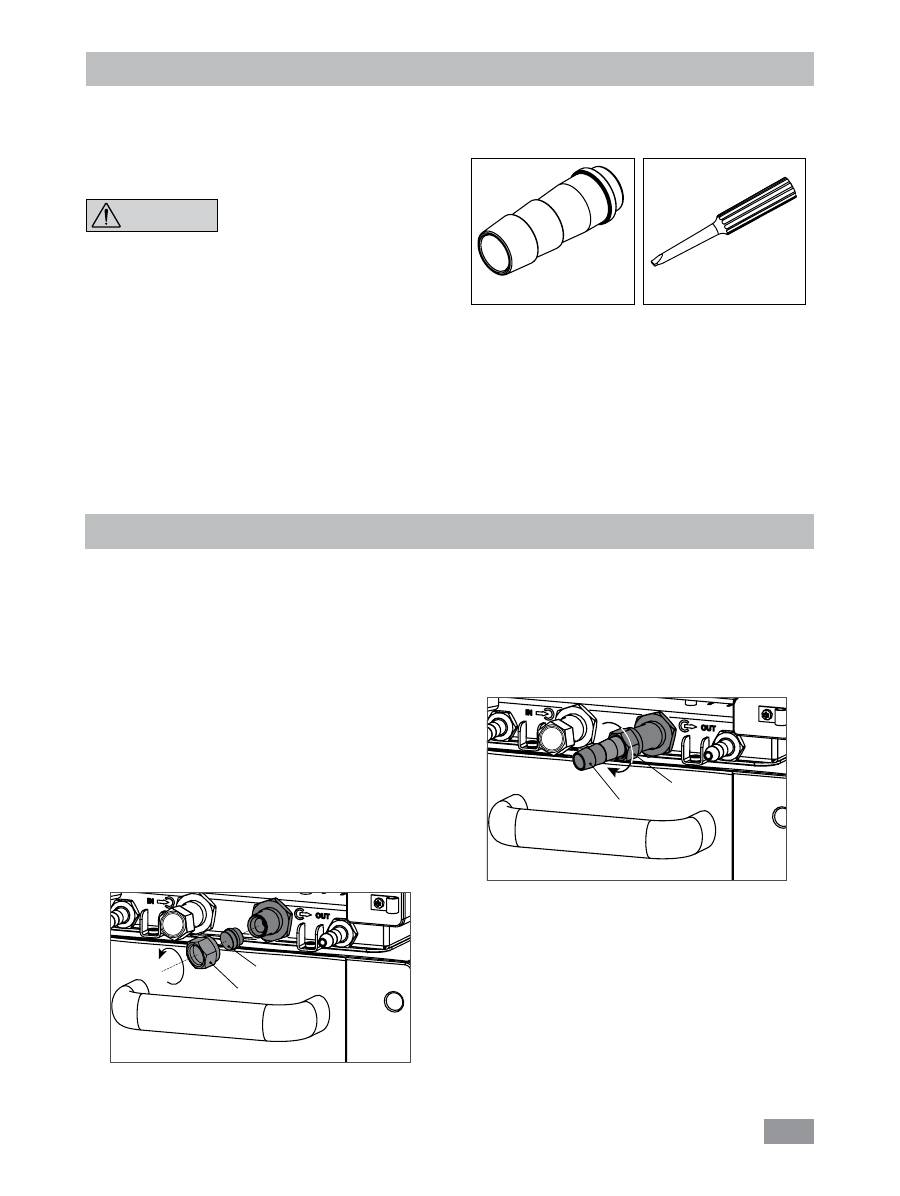
26
Unpacking
• Unpacking
- Please unpack the device carefully
- In the case of any damage a detailed report must be sent
immediately (post, rail or forwarder).
Transport safety
- Remove the transport protection
under the
buoyage
(
4
). For
HBC
device,
you need to open the lid
(
16
) and remove the protection.
• Delivery scope
IC basic, HBC basic, HBC 10 basic
-
IC baisc
Immersion Circulator or
HBC 5 basic
Heating
Bath Circulator or
HBC 10 basic
Heating Bath Circulator
according to the order
- Mains cables
H 12
- Hose olive NW 12 (2 pieces)
see
Fig. 5
- Screwdriver (use for safety circuit)
see
Fig. 6
- Operating instructions
- Warranty card.
Preparations
• Setting up
- Place the device on an even, stable, clean, nonslip, dry
and fireproof surface.
- Keep at least 20 cm of open space at the front and
rear side.
- When a plastic bath is used, please ensure that the heat-
er does not contact the bath.
- The place for installation should be large enough and
provide sufficient air ventilation to ensure the room
does not warm up excessively because of the heat
from device radiates to the environment.
- Do not set up the device in the immediate vicinity of
heat sources and do not expose to sun light.
• Connecting the tubings
- Unscrew the union nuts and stoppers using a wrench
from the pump connection
IN (8)
and
OUT (9)
.
Fig. 6
Fig. 5
Additional for HBC 5 basic / HBC 10 basic:
- Temperature sensor Pt 100.30.
- Connect the hoses for circulating the external system to
the pump connectors
M 16 x 1
for
IN
and
OUT
directly
or with the olives.
- Screw the hose olive to the pump connection
IN
and
OUT
with union nuts. Slide the hoses (NW 12) onto the
olives. The hoses must be secured with suitable clamps.
Note:
Please note the permissible temperature range of hos-
es. For hot fluids we recommend the
IKA
®
LT 5.20
hoses.
When the external system is not necessary, please seal the
pump connectors
IN
and
OUT
with the existing union
nuts and stoppers.
Stopper
Union nut
Hose olive
Union nut
Fig. 7
Fig. 8
CAUTION
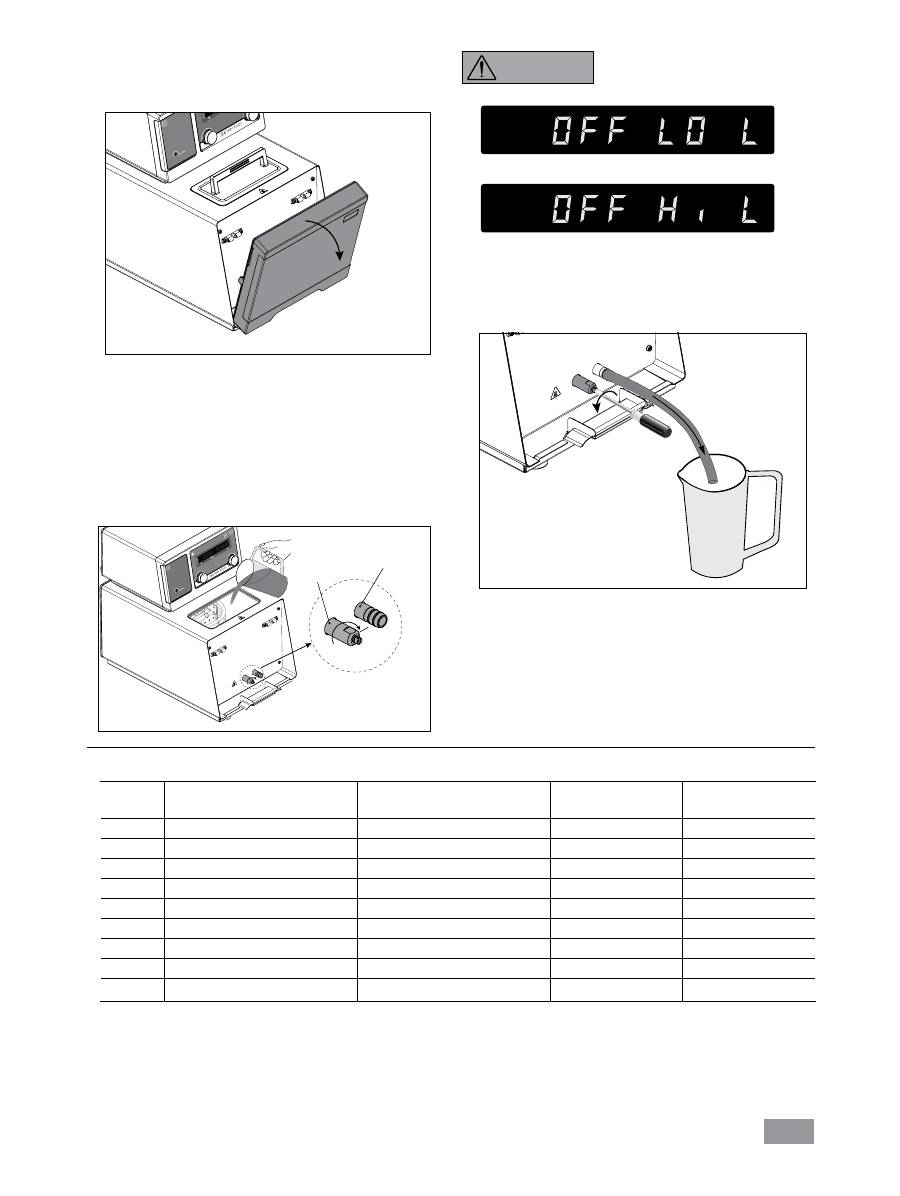
27
Fig. 10
Fig. 11
Low Level
High Level
WARNING
•
Fluids
No.
IKA
®
Designation
Operating temperature range
(
°C
)
Safety temperature
(
°C
)
Flash point
(
°C
)
0
EG19_N10.100 (H
2
0 + Glycole)
-10 ... 100
100
125
1
EG34_N20.100 (H
2
0 + Glycole)
-20 ... 100
100
125
2
EG40_N25.100 (H
2
0 + Glycole)
-25 ... 100
100
125
3
EG45_N30.100 (H
2
0 + Glycole)
-30 ... 100
100
125
4
SI_P20.275 (Silcone Oil)
20 ... 275
275
300
5
SI_N30.145 (Silicone Oil)
-30 ... 145
145
170
6
SY_N10.100 (Synthetic Oil)
-10 ... 100
100
125
7
Water*
5 ... 95
95
—
8
Customized
*
Note:
Tap water may be unsuitable for operation because the calcium carbonate content may cause calcification.
High purity water (from icon exchangers) and distilled or bi-distilled water are unsuitable for operation due to corrosive
properties of these media. High purity water and distillates are suitable as a medium after adding 0,1 g soda (Na
2
CO
3
,
sodium carbonate) per liter of water.
Fig. 9
• Filling and draining
- Before filling the fluid into the bath, open the front
cover as indicated in following figure.
- Check and make sure that the drain valve is closed (the
stop position in clockwise direction, see
Fig. 10
).
Note:
Please note information in chapter “
Commis-
sioning
”.
- Connect the mains plug and turn on the device with
mains switch (
2
).
- The low level warning message appear on the display.
- Open the lid (
16
) and fill fluid to the bath.
Note:
Pay attention to the fluid
level information on the display:
- To drain the fluid from the bath, connect a hose to the
drain port and turn the drain valve in counter clockwise
direction with a straight screwdriver.
Drain valve
Drain port
Stop position
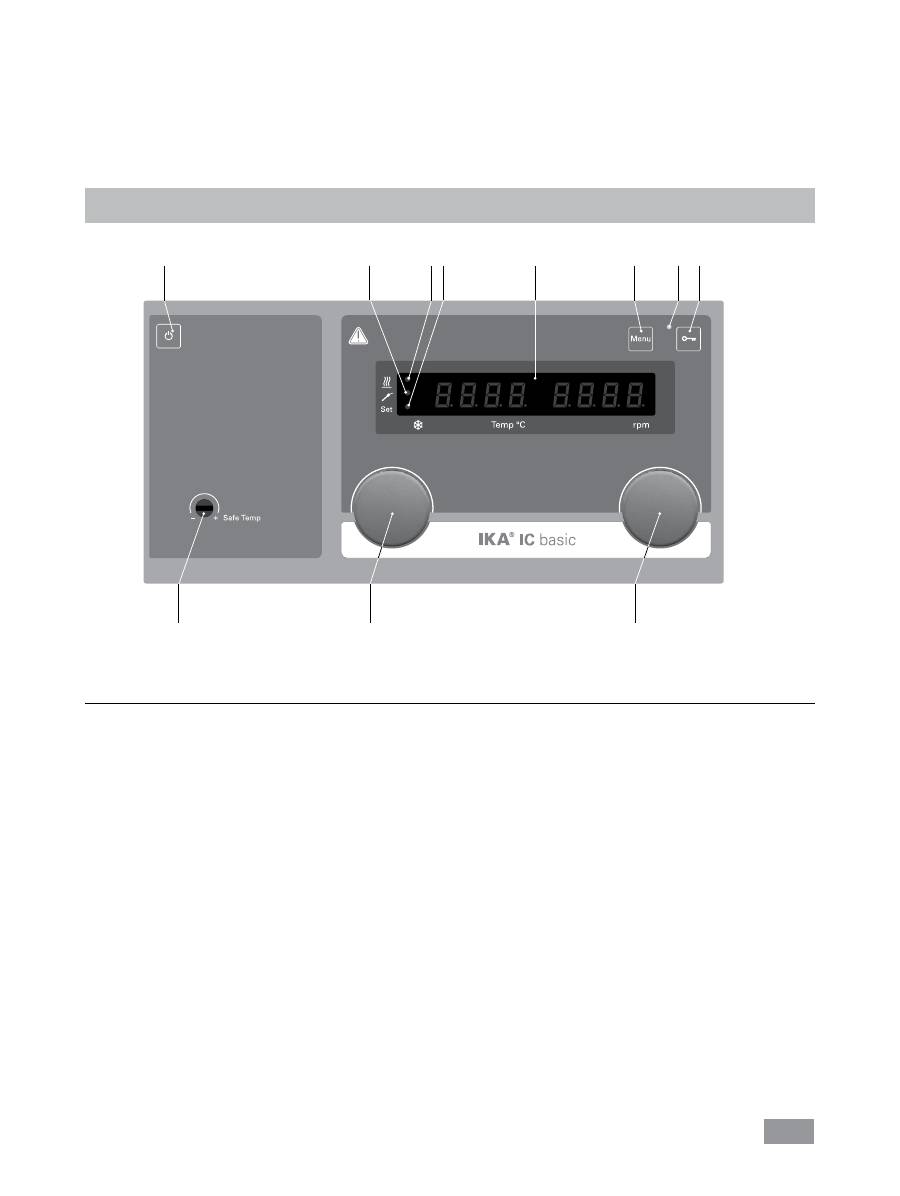
28
• Cooling coil
When the set temperature is close to the ambient tem-
perature, the cooling coil should be used for counter-
cooling due to the self-heating.
Connect the water supply and return line hoses to the
cooling coil connectors (see
Fig. 4
).
For bath temperatures > 95 °C do not use the cooling coil
with water.
For bath temperatures > 60 °C make sure that the flow
rate through the cooling coil is high enough, to avoid
excessive calcification.
Operator panel and display
B
C
A
D
K
J
I
G
E
M F
Fig. 12
Item Designation
Function
A
ON/OFF button:
Switch on/off the circulator.
B
Rotating/pressing knob:
Set the temperature value.
Start/stop the heating function.
Navigation, selecting the settings in the menu.
C
Rotating/pressing knob:
Set the pump speed value.
Start/stop the pump function.
Set and confirm the menu options.
D
Adjustable safety circuit:
Adjust the safety temperature limit with delivered screwdriver.
E
Menu button:
Press it once: menu option is display.
Press it a second time: back to the working screen.
F
Key button:
Lock/unlock keys and knobs.
G
LED display:
Display the settings and actual values.
I
LED, heater:
Indicate the heating function is activated.
J
LED, temperature sensor:
Indicates that an external temperature sensor is connected.
K
LED, set:
The LED lights up at the same time as the set value is displayed.
M
LED
,
key button
Indicates that the function of keys and knobs is deactivated.
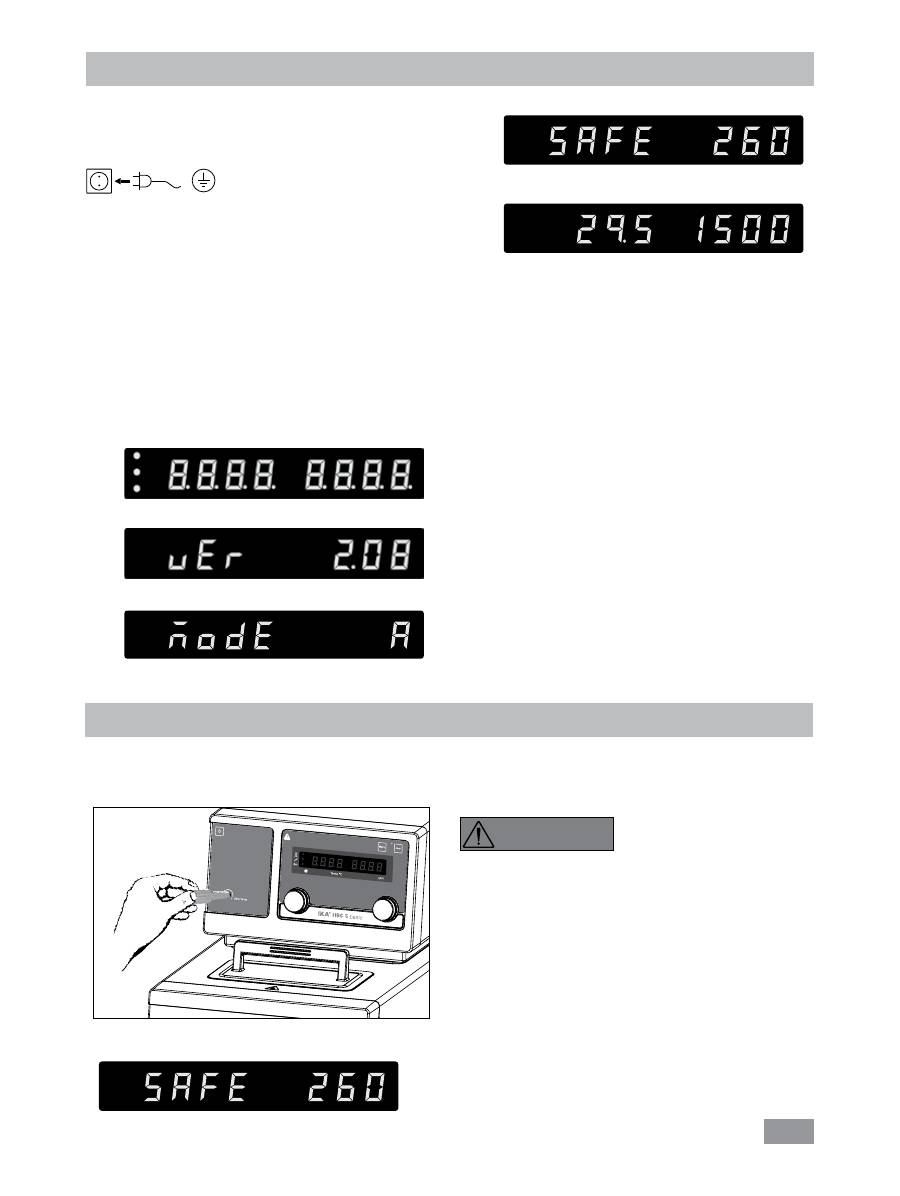
29
Commissioning
Check whether the voltage specified on the type plate
matches the mains voltage available.
The power socket used must be
earthed (protective earthing).
If above conditions are met, the device is ready for opera-
tion after plugging in the mains plug.
If these conditions are not met, safe operation is not guar-
anteed and the device could be damaged.
Observe the ambient conditions (temperature, humidity,
etc.) listed under “
Technical Data
”.
After switching on the mains switch (
2
) at the back of the
device or pressing the power key (
A
), all LED segments
light up during the self test. Then the software version,
operating mode, safety temperature and working settings
will be shown.
Then the device enters standby status and is ready for op-
eration.
Change the temperature setting with left knob (
B
).
Change the pump speed setting with the right knob (
C
).
Press the left knob (
B
) in standby status. The device start
heating function, meanwhile the pump start to run.
Press the right knob (
C
) in working status to stop the pump
function. The heating function and pump stops.
Note:
In standby status,
press the right knob (
C
) to start
the pump function. The heating function will not be ac-
tivated.
In working status, press the left knob (
B
) to stop the heat-
ing function, the pump keep running.
Setting the safety temperature
Adjust the safety temperature with screwdriver delivered
with the device.
The safety temperature setting will appear on the display.
DANGER
Factory setting: approximate max. value
Adjustment range: 0
–
260 °C
Note:
The safety temperature
must always be set to at least
25 ºC lower than the flash point
of the fluid used.
Safety temperature (safe)
Fig. 13
Software version (ver)
Safety temperature (safe)
Working setting
Starting
Operating mode (mode)
HBC 5
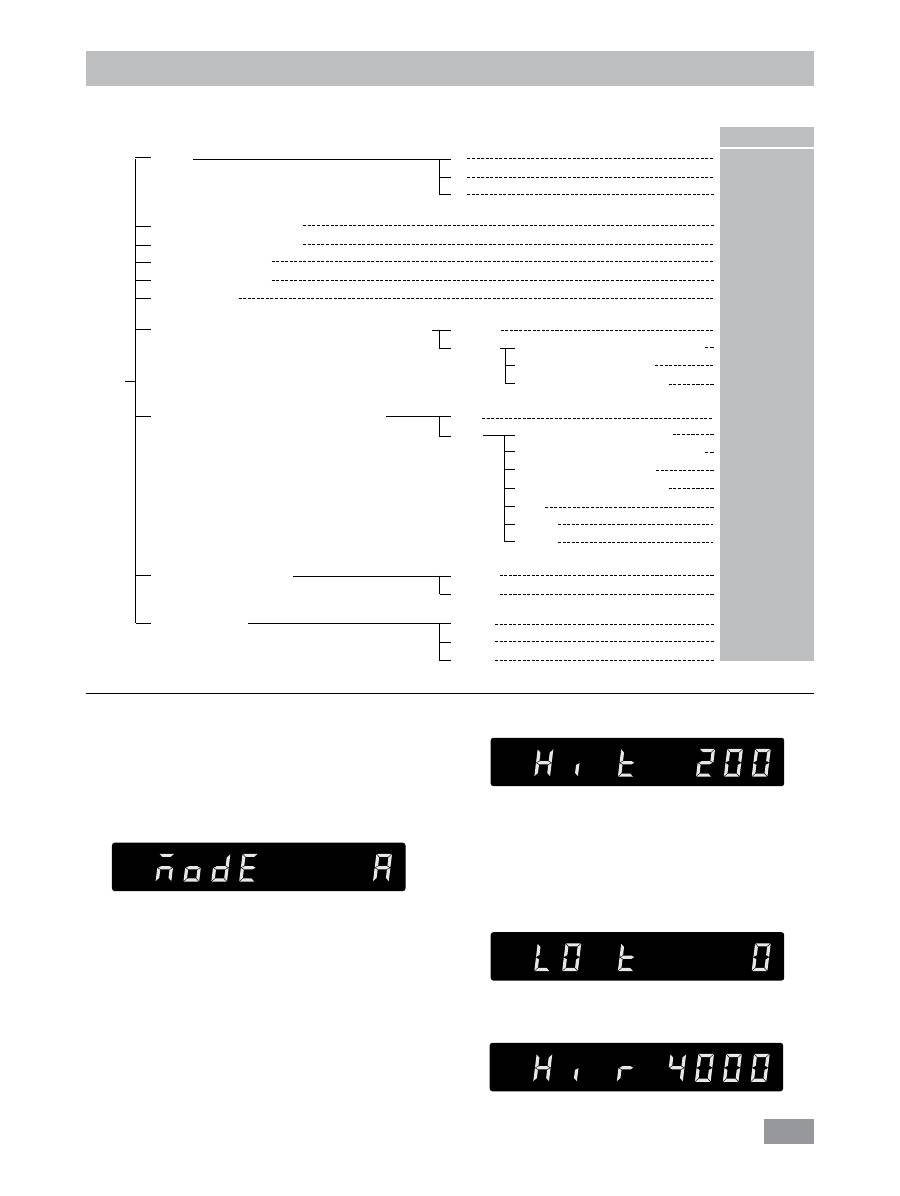
30
Menu settings
MODE
Maximum temperature (HI T)
Minimum temperature (LO T)
Maximum speed (HI R)
Minimum speed (LO R)
Fluid type (FLUI)
The type of temperature PID control arithmetic (AUTO)
External and internal temperature control (ET)
Alarm and key tone (BEEP)
Calibration (CALI)
Menu
•
Menu structure
Default settings
A
B
C
Proportional coefficient of PID (Kp 1)
Integrate time of PID (Ti 1)
Differential time of PID (Td 1)
AUTO 1
AUTO 0
External sampling time (EuT 2)
Proportional coefficient of PID (Kp 2)
Integrate time of PID (Ti 2)
Differential time of PID (Td 2)
DF t
FASt 0
FASt 1
ET 0
ET 1
BEEP 0
BEEP 1
CALI 0
CALI 2
CALI 3
activated
-
-
200 °C
0 °C
4000 rpm
1000 rpm
0
-
15,0
5,00
5,0
activated
120 s
1,0
1,5
0,0
100,0
-
activated
-
activated
activated
-
-
•
Basic guide to setting the menu options:
F
Enter the menu by pressing ”Menu” key (
E
).
F
Turn the left knob (
B
) to select a menu option.
F
Turn the right knob (
C
) to change the menu value settings.
F
Confirm the menu settings by pressing the right knob (
C
).
•
Operating mode (MODE)
Mode A:
After power on/power failure no automatic
restart of functions.
Mode B:
After power on/power failure automatic re-
start of functions, depending on previous settings.
Mode C:
Set values (set in A or B) cannot be changed.
After power on/power failure automatic restart of func-
tions, depending on previous settings.
•
Maximum temperature (HI T)
The maximum adjustable value: 200° C. This value can
be limited additionally by the selected liquid (No., see
“
Settings
” fluid type).
Note:
The maximum value is limited by the set safety
temperature.
•
Minimum temperature (LO T)
The minimum adjustable value: 0° C
•
Maximum speed (HI R)
The maximum adjustable value: 4000 rpm.
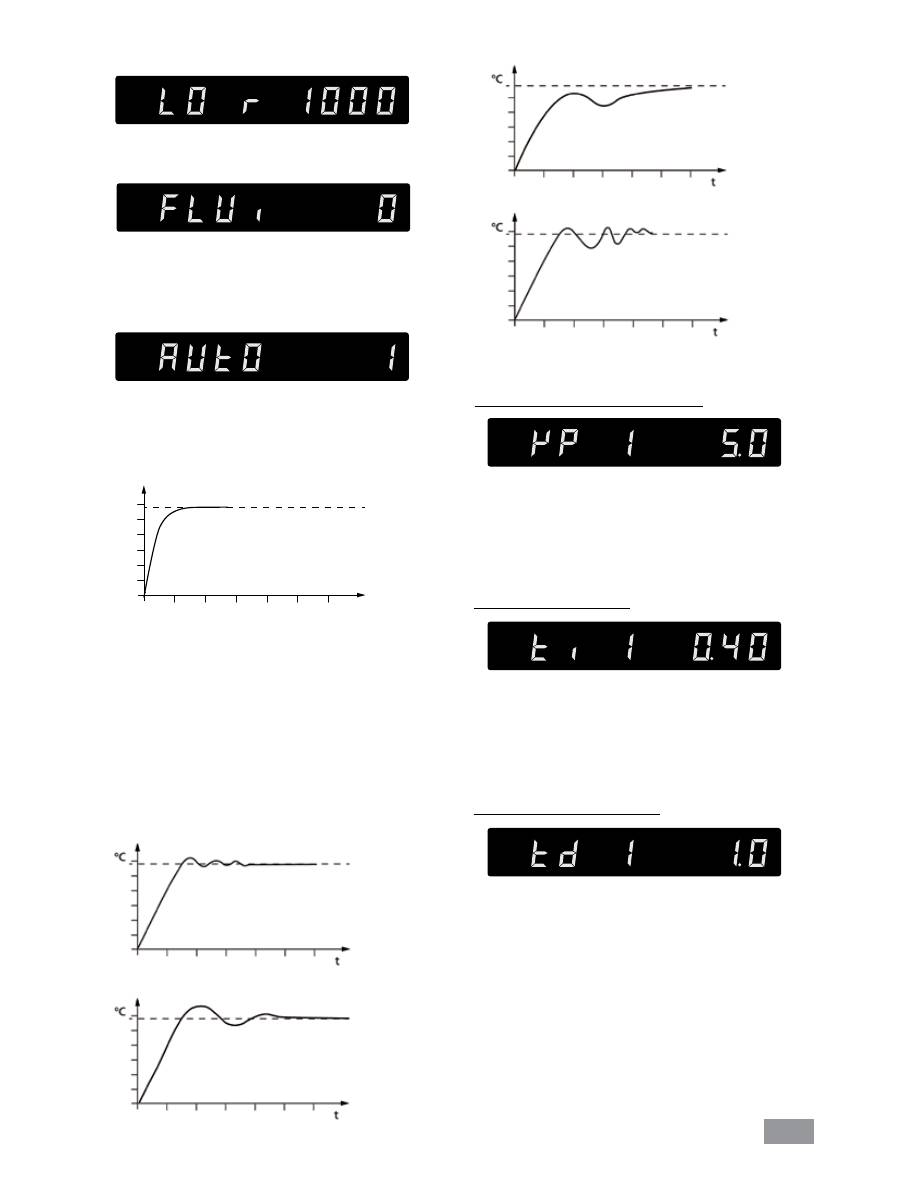
31
•
Minimum speed (LO R)
The minimum adjustable value: 1000 rpm
•
Fluid type
(
FLUI
)
The chosen fluid (No.) of the temperature setting is lim
-
ited. See Section “
Fluid
”.
•
Temperature control type (AUTO)
AUTO 1:
AUTO 1
is the default setting. The optimum settings are
determined automatically.
Heat-up curve in auto-tuning control (
AUTO 1
):
Fig. 15
°C
t
Proportional coefficient of PID (
Kp 1
)
Integral time of PID (
Ti 1
)
Differential time of PID (
Td 1
)
Fig. 14
The proportional coefficient
Kp
is the controller ampli-
fication and determines how strongly the control devia-
tion (the difference between the target temperature and
actual temperature) directly affects the control variable
(on-time of the heater).
Kp
values that are too large can
lead to the controller overshooting.
The integral time
Ti (s)
is the correction time and deter-
mines how strongly the duration of the control devia-
tion affects the control variable.
Ti
compensates an ex-
isting control deviation. A high
Ti
means a smaller and
slower effect on the control variable.
Ti
values that are
too small can lead to instability of the controller.
The differential time
Td (s)
is the derivative time and de-
termines how strongly the rate of change of the control
deviation affects the control variable.
Td
compensates
for rapid control deviations. A high
Td
means a smaller
and slower effect on the control variable.
Td
values that
are too small can lead to instability of the controller.
AUTO 0:
For special requirements,
AUTO 0
can be used with
manual adjustment of the control parameters.
If the PID control (
AUTO 0
) option is selected, the fol-
lowing items including
Kp 1
,
Ti 1
and
Td 1
could be
set. Otherwise they are not displayed in the menu list.
Note:
Inappropriate settings may produce the follow-
ing heat-up curves:
Kp too high
Ti too low
Td too high
Kp too low
Ti too high
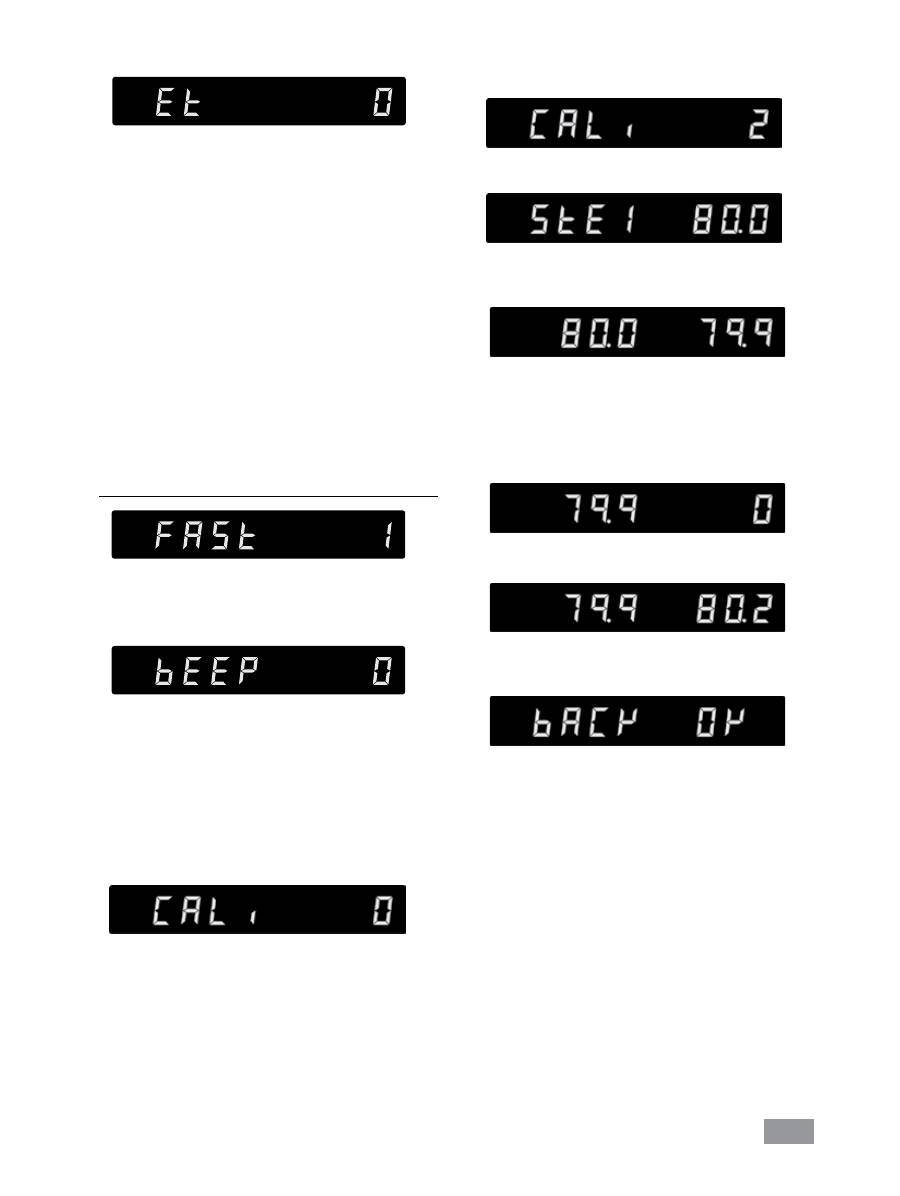
32
•
External and internal temperature control (ET)
ET 0:
internal temperature control
ET 1:
external temperature control
If the external temperature control (
ET 1
) is selected,
the following items
EuT 2
(sampling time),
Kp 2
,
Ti 2
,
Td 2
,
Df t
(maximum temperature difference between
internal and external temperature) and
FAST
could be
set. Otherwise they are not displayed in the menu list.
The sampling time
EuT 2
(s) is the interval over which
the external control deviation and the respective con-
trol variable (dependent on
Kp 2
,
Ti 2
,
Td 2
,
Df t
and
FAST
) is determined.
EuT 2
must be adjusted to match the response charac-
teristic (total of all time constants) of the external closed
loop controlled system, so that the control variable can
deliver a uniform and measurable change in the control
deviation.
EuT 2
values that are too small or too large
can lead to instability of the controller.
Dynamics of the external PID temperature control (
FAST
)
FAST=0:
accurate, without overshoot
FAST=1:
fast, with overshoot
•
Alarm and key tone (BEEP)
BEEP 0:
no alarm and key tone
BEEP 1:
alarm and key tone is activated
•
Calibration and adjustment (CALI)
CALI 0:
no calibration
CALI 2:
2-point calibration
CALI 3:
3-points calibration
Example: 2-point calibration:
Dip the temperature sensor of the reference measuring
instrument into the bath fluid:
- If
ET 0
: into the internal bath (open the lid (
16
))
- If
ET 1
: at the same position as the external Pt100
temperature sensor (
12
).
Set the first point temperature (e.g. 80 °C). Confirm the
setting by pressing the right knob (
C
).
Left area of the display appears the set value (80 °C) and
the right area of the display appears the actual tempera-
ture value measured. The set LED (
K
) flashes briefly.
The unit now starts and controls to the set value. When
the temperature has reached the set value and has be-
come constant, the “Set” LED (
K
) no longer flashes and
the following display appears.
The temperature measured by the unit appears on the
left hand side.
Input the calibration value from the reference mesuring
instrument (e.g. 80.2 °C) with the right knob (
C
).
Confirm the value by pressing the right knob (
C
).
Back to previous screen for input a new value by press-
ing the left knob (
B
).
Back
OK
The first point calibration is finished now.
Calibration of the other points is performed in the same
way.
If
ET 0
: adjustment of the internal temperature mea-
surement.
If
ET 1
: adjustment of the external temperature mea-
surement.
Select 2-point calibration in the menu. Press the right
knob (
C
) to start the 2-point calibration.
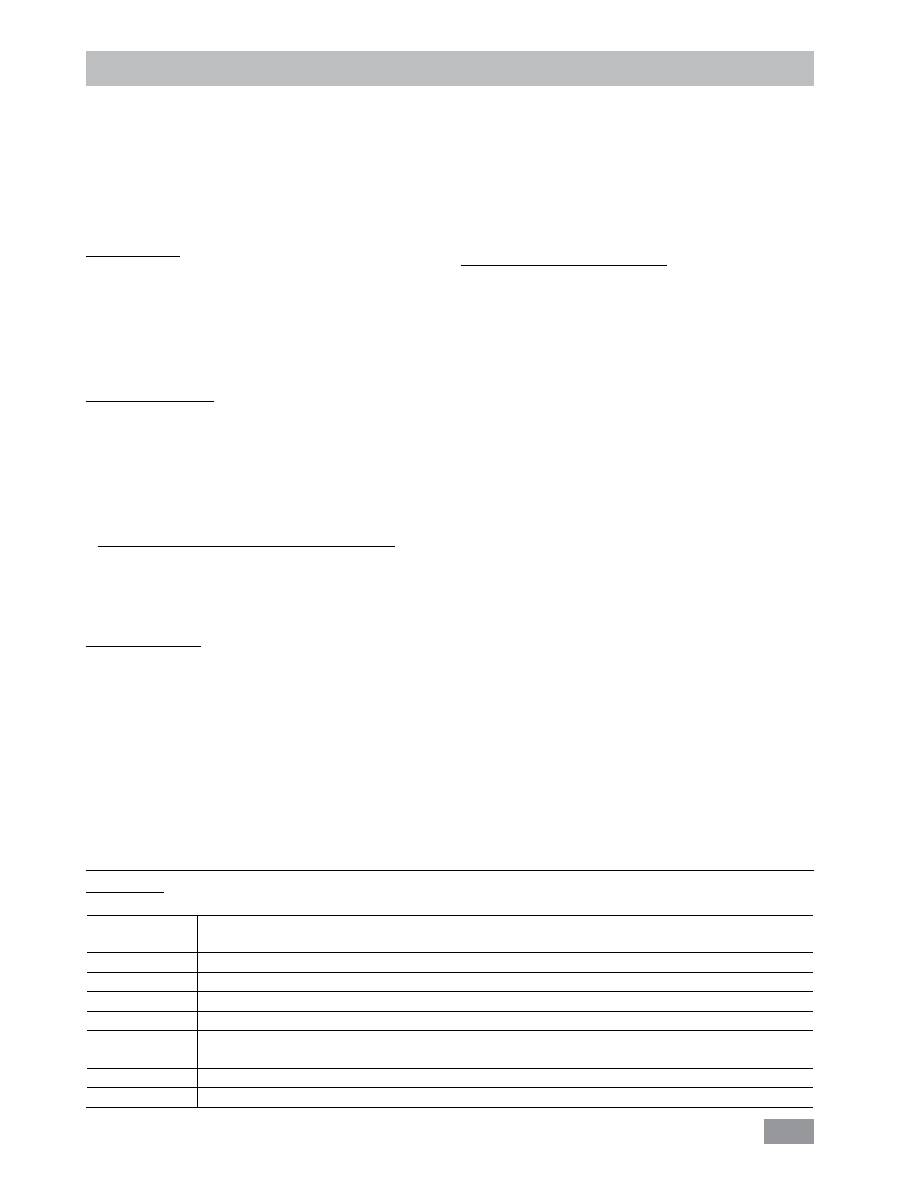
33
Interface and output
The device can be operated in “Remote” mode via the RS 232
interface (
10
) or the USB interface (
11
) connected to a PC
and with the laboratory software Labworld
soft
®
.
Note:
Please comply with the system requirements to-
gether with the operating instructions and help section
included with the software.
USB interface
The Universal Serial Bus (USB) is a serial bus for connect-
ing the device to the PC. Equipped with USB devices can
be connected to a PC during operation (hot plugging).
Connected devices and their properties are automatically
recognized. The USB interface can also be used to update
firmware.
USB device drivers
After the device is connected to the PC through the USB
cable, it tells the Windows operating system with which
device drivers are required.
Windows operating system will then either:
- load the driver
- install the driver if it is not already installed
- require manual installation, select:
http://www.ika.net/ika/lws/download/stmcdc.inf
The data communication is via a virtual COM port.
Configuration, command syntax and commands of the vir-
tual COM ports are as described in RS 232 interface.
RS 232 interface
Configuration
- The functions of the interface connections between the
stirrer machine and the automation system are chosen
from the signals specified in EIA standard RS 232 in ac-
cordance with DIN 66 020 Part 1.
- For the electrical characteristics of the interface and the
allocation of signal status, standard RS 232 applies in ac-
cordance with DIN 66 259 Part 1.
- Transmission procedure: asynchronous character trans-
mission in start-stop mode.
- Type of transmission: full duplex.
- Character format: character representation in accordance
with data format in DIN 66 022 for start-stop mode. 1
start bit; 7 character bits; 1 parity bit (even); 1 stop bit.
- Transmission speed: 9600 bit/s.
- Data flow control: none
- Access procedure: data transfer from the stirrer machine to
the computer takes place only at the computer’s request.
Command syntax and format
The following applies to the command set:
- Commands are generally sent from the computer (Master)
to the device (Slave).
- The device sends only at the computer’s request. Even
fault indications cannot be sent spontaneously from the
device to the computer (automation system).
- Commands are transmitted in capital letters.
- Commands and parameters including successive parame-
ters are separated by at least one space (Code: hex 0x20).
- Each individual command (incl. parameters and data)
and each response are terminated with Blank CR LF
(Code: hex 0x20 hex 0x0d hex 0x20 hex 0x0A) and have
a maximum length of 80 characters.
- The decimal separator in a number is a dot (Code: hex
0x2E).
The above details correspond as far as possible to the rec-
ommendations of the NAMUR working party (NAMUR rec-
ommendations for the design of electrical plug connections
for analogue and digital signal transmission on individual
items of laboratory control equipment, rev. 1.1).
The NAMUR commands and the additional specific
IKA
®
co mmands serve only as low level commands for commu-
nication between the device and the PC. With a suitable
terminal or communications programme these commands
can be transmitted directly to the circulator equipment. The
IKA
®
software package, Labworld
soft
®
, provides a conve-
nient tool for controlling circulating equipment and collect-
ing data under MS Windows, and includes graphical entry
features, for pump motor speed ramps for example.
The following table summarizes the (NAMUR) commands
understood by the
IKA
®
control equipment.
Commands
NAMUR
Commands
Function
IN_PV_1
Read the external actual temperature
IN_PV_2
Read the internal actual temperature
IN_PV_3
Read the safety actual temperature
IN_PV_4
Read the pump actual speed
IN_SP_1
Read the internal setting temperature (if ET=0)
Read the external setting temperature (if ET=1)
IN_SP_3
Read the safety setting temperature
IN_SP_4
Read the pump setting speed
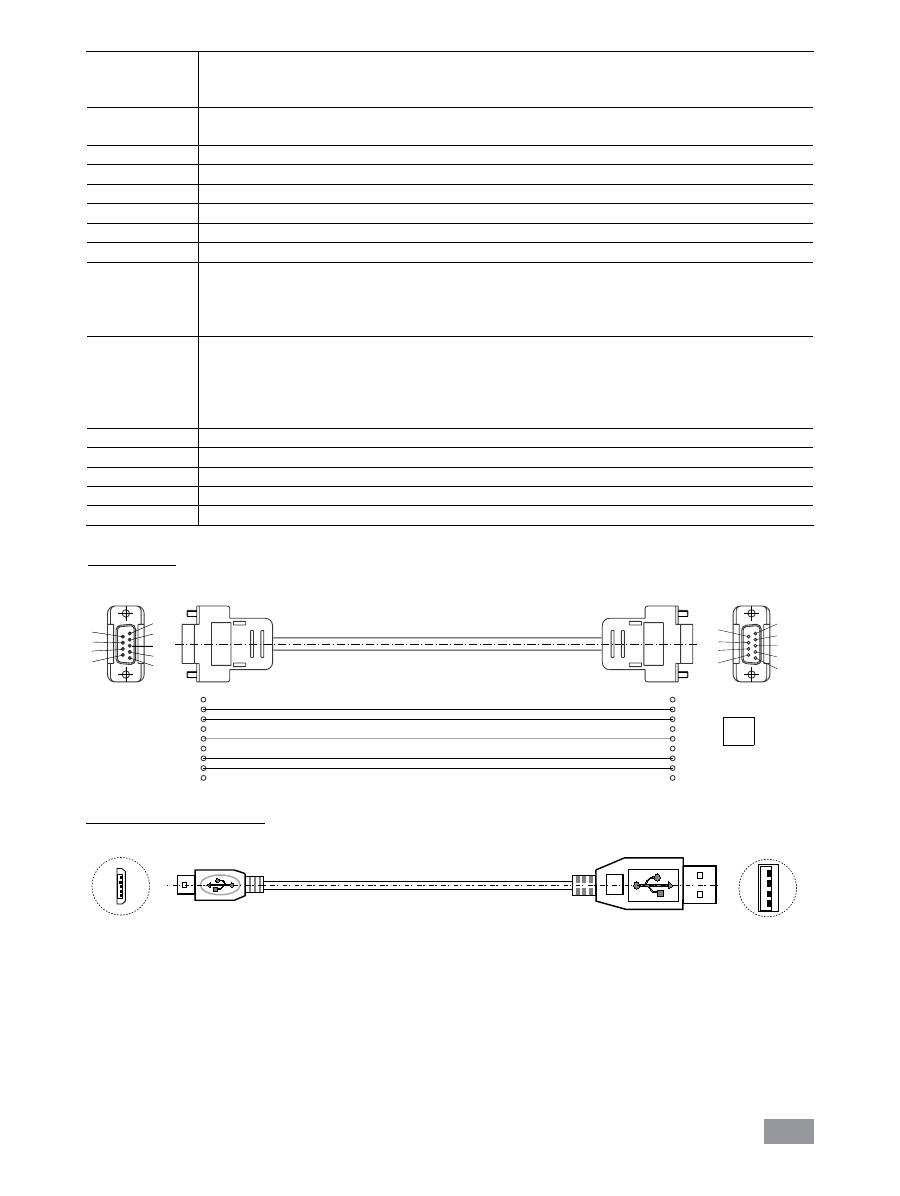
34
PC 1.1 Cable
This cable is required to connect RS 232 port (
10
) to a PC.
1
2 RxD
3 TxD
4
5 GND
6
7 RTS
8 CTS
9
1
RxD 2
TxD 3
4
GND 5
6
RTS 7
CTS 8
9
PC
1
2
3
4
5
6
7
8
9
9
8
7
6
5
4
3
2
1
Fig. 16
USB cable A - Micro B 2.0
This cable is required to connect USB port (
11
) to a PC.
USB micro B
USB A
A
Fig. 17
IN_TMODE
Read temperature control
0: internal regulation
1: external regulation
OUT_SP_1 xxx
Set the internal setting temperature XXX (if ET=0)
Set the external setting temperature XXX (if ET=1)
OUT_SP_12@n
Set the WD safety temperature with echo of the set (defined) value.
OUT_SP_4 xxx
Set the pump speed XXX
OUT_SP_42@n
Set the WD-safety speed with echo of the set (defined) value.
IN_STATUS
Status bits
OUT_TMODE_0
Set to Internal temperature control
OUT_TMODE_1
Set to External temperature control
OUT_WD1@n
Start the watchdog mode 1 and set the time for the watchdog to n (20...1500) seconds.
Echo of the Watchdog time.
During a WD1-event, the heating and pump functions are switched off.
This command needs to be send within the watchdog time.
OUT_WD2@n
Start the watchdog mode 2 and set the watchdog time to n (20...1500) seconds.
Echo of the watchdog time.
During a WD2-event, the set temperature is changed to the WD safety temperature and the pump set
speed is set to the WD safety speed.
This command needs to be send within the watchdog time.
RESET
Reset the PC control and stop the device functions.
START_1
Start the heating function
START_4
Start the pump function
STOP_1
Stop the heating function
STOP_4
Stop the pump function
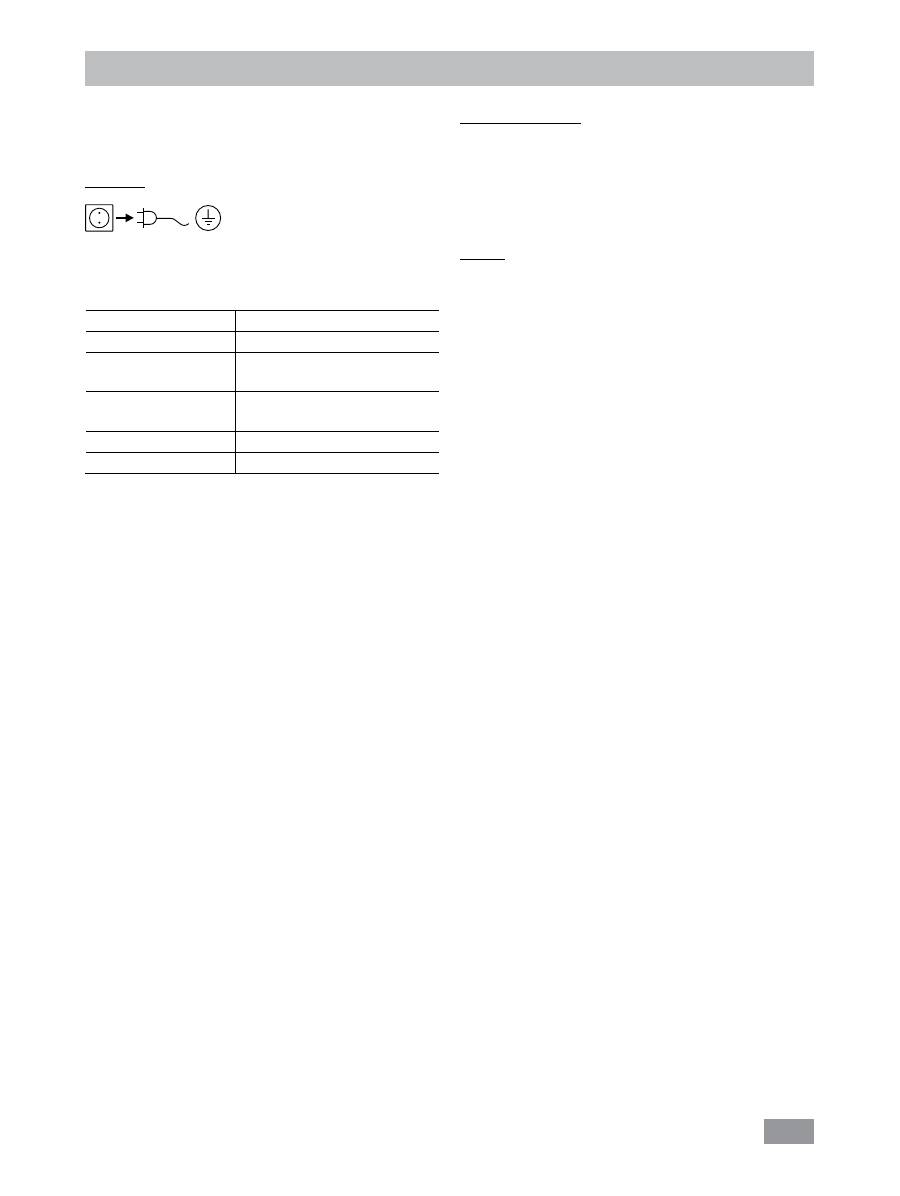
35
Maintenance and cleaning
The device is maintenance-free. It is only subject to the
natural wear and tear of components and their statistical
failure rate.
Cleaning
For cleaning disconnect the mains
plug!
Use only cleaning agents which have been approved by
IKA
®
to clean
IKA
®
devices.
Dirt
Cleaning agent
Dye
Isopropyl alcohol
Construction material
Water containing tenside/
isopropyl alcohol
Cosmetics
Water containing tenside/
isopropyl alcohol
Foodstuff
Water containing tenside
Fuel
Water containing tenside
For materials which are not listed, please request
information from IKA
®
application support.
Wear protective gloves while cleaning the device.
Electrical devices may not be placed in the cleansing agent
for the purpose of cleaning.
Do not allow moisture to get into the device when cleaning.
Before using another than the recommended method for
cleaning or decontamination, the user must ascertain with
IKA
®
that this method does not damage the device.
Spare parts order
When ordering spare parts, please give:
- machine type
- manufacturing number, see type plate
- item and designation of the spare part,
see
www.ika.com
, spare parts diagram and list
- Software version.
Repair
Please send the device for repair only after it has
been cleaned and is free from any materials which
may constitute a health hazard.
For repair, please request the “
Decontamination Clear-
ance Certificate
” from
IKA
®
, or download printout of it
from the
IKA
®
website
www.ika.com
.
If you require servicing, return the device in its original
packaging. Storage packaging is not sufficient. Please also
use suitable transport packaging.

36
Error codes
Any malfunctions during operation will be identified by an error message on the display.
Proceed as follows in such cases:
F
Switch off device using the main switch at the back of the device
F
Carry out corrective measures
F
Restart device
Error code
Effect
Cause
Solution
Err 01
Pump off
Heating off
No External Pt 100 temperature
sensor
- Check this sensor
Err 02
Pump off
Heating off
Motor Over current (rate
current)
- Reduce pump motor speed
- Use fluid with lower viscosity
- Check if the pump impeller is blocked
Err 03
Pump off
Heating off
Motor Over current (Max
current)
- Reduce pump motor speed
- Use fluid with lower viscosity
- Check if the pump impeller is blocked
Err 04
Pump off
Heating off
Motor Hall signal missing
- Reduce pump motor speed
- Use fluid with lower viscosity
- Check if the pump impeller is blocked
Err 05
Pump off
Heating off
Too high liquid level
- Check the liquid level and buoyage
Err 06
Pump off
Heating off
Too low liquid level
- Check the liquid level and buoyage
Err 07
Pump off
Heating off
Too high voltage
- Check the mains power
Err 08
Pump off
Heating off
Too low voltage
- Check the mains power
Err 09
Pump off
Heating off
Device internal temperature is
too high
- Check the ambient temperature and let the device
cool down
Err 10
Pump off
Heating off
PC communication failure
- Check communication cable
Err 11
Pump off
Heating off
Temperature difference
between control sensor and
safety sensor is too much
- Check safety temperature circuit and bath fluid
Err 12
Pump off
Heating off
Safety temperature alarm
- Check the bath temperature measurement
Err 13
Pump off
Heating off
Heater switched off by safety
circuit
- Check safety temperature set value, fluid level
Err 14
Pump off
Heating off
Fan error
- Check the fan and clean the grids at the rear side
If the actions described fails to resolve the fault or another error code is displayed then take one of the following steps:
- Contact the service department;
- Send the device for repair, including a short description of the fault.

37
Accessories
IC basic
HBC 5 basic
HBC 10 basic
Water bath protective media
AQ.1
Aquacide 1
•
•
•
Tubing and hoses
LT 5.20
metal hose (isolated M16 x 1)
•
•
•
H.PVC.8
PVC hose (nominal width 8)
•
•
•
H.PVC.12
PVC hose (nominal width 12)
•
•
•
H.SI.8
silicone hose (nominal width 8)
•
•
•
H.SI.12
silicone hose (nominal width 12)
•
•
•
H.PTFE.8
PTFE hose (nominal width 8)
•
•
•
H.PTFE.12
PTFE hose (nominal width 12)
•
•
•
Tubing Insulations
ISO. 8
insulation (8 mm)
•
•
•
ISO.12
insulation (12 mm)
•
•
•
Bath vessels
IB pro 12
stainless steel bath
•
IB pro 20
stainless steel bath
•
Bridges and Covers
BS.IC
small bridge (for
IB pro 12
,
IB pro 20
)
•
CM.IC
medium cover (for
IB pro 12
)
•
CL.IC
large cover (for
IB pro 20
)
•
Additional accessories
RV 10.5003
pressure regulating valve
•
•
•
RV 10.5002
filter
•
•
•
Pt 100.30
temperature sensor
•
PC 1.1
cable (RS 232)
•
•
•
USB Kabel A - Micro B 2.0
•
•
•
CC 1
Cooling coil
•
LT 5.24
hose adapter
•
•
•
Labworld
soft
®
•
•
•
See more accessories on
www.ika.com.
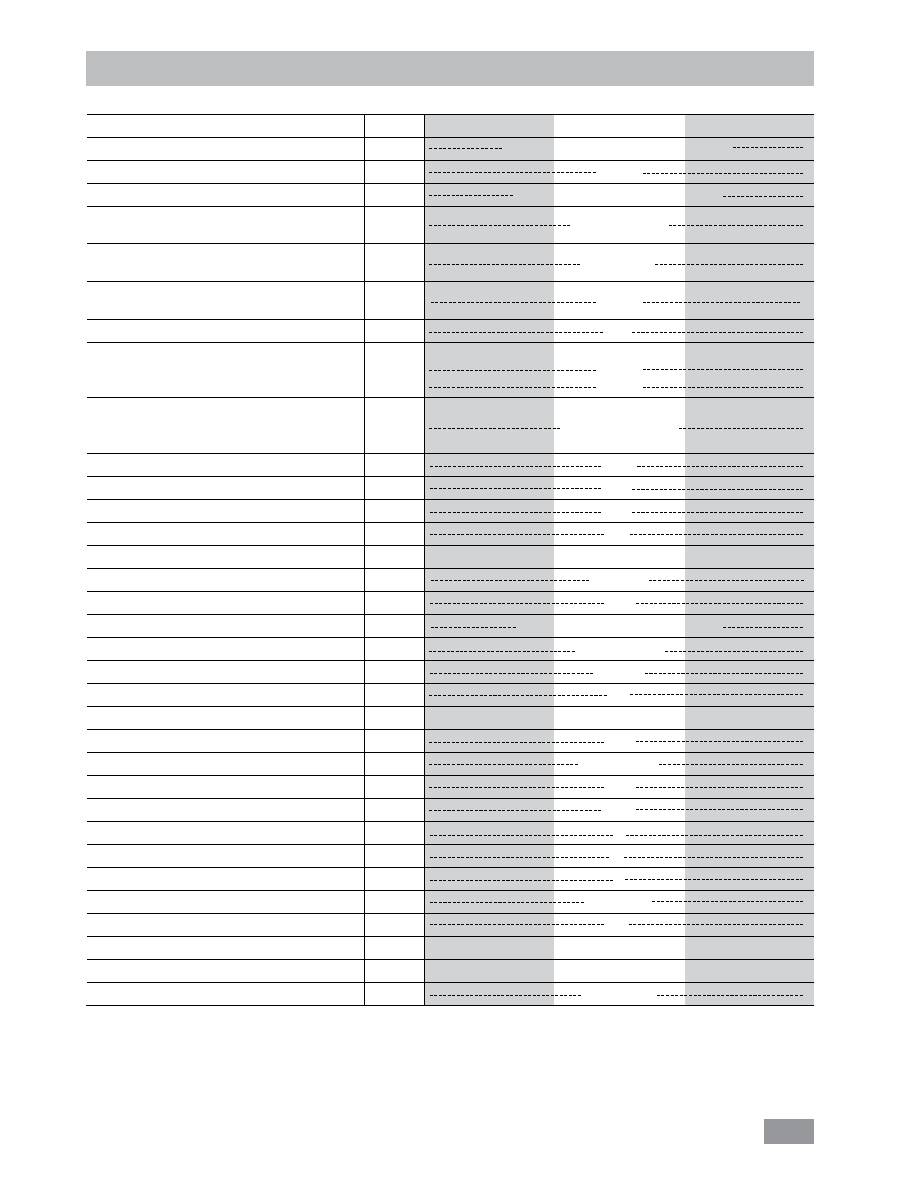
38
Technical data
IC basic
HBC 5 basic
HBC 10 basic
Nominal voltage
VAC
230 ±10% (EURO) / 115 ±10% (USA)
Frequency
Hz
50/60
Max. input power
W
2650 (230 VAC)/1400 (115 VAC)
Working temperature range
(RT+10 at 1000rpm)
°C
RT + 10 ... 200
Operating temperature range
(with forced cooling)
°C
-20 ... 200
Temperature stability – Internal temperature
control 70°C, water (according to DIN12876)
K
± 0,02
Temperature control
PID
Temperature measurement, absolute accuracy
Internal (int) (adjustable by calibration)
External (ext) (adjustable by calibration)
K
K
± 0,2
± 0,2
External Pt 100.5 temperature sensor tolerance
to DIN EN 60751 class A, ≤ ± (0.15 + 0.002 x |T|),
e.g. at max. 100°C (adjustable by calibration)
K
± 0,35 (at 100 °C)
Temperature setting
Knob
Temperature setting resolution
K
0,1
Temperature display
LED
Temperature display resolution
K
0,1
Classification according to DIN12876-1
Class III (FL) suitable for flammable and non-flammable fluids
Safety circuit (adjustable)
°C
0 ... 260
Safety temperature display
LED
Heating capacity
W
2500 (230 VAC)/1250 (115 VAC)
Pump speed (adjustable)
rpm
1000 ... 4000
Max. pump pressure/suction
bar
0,5/0,3
Max. flow rate (at 0 bar)
l/min
20
Bath volume
I
-/-
5 - 7
8 - 11
Sub-level protection
Yes
Interface
USB, RS 232
Permitted on-time
%
100
Protection class according to EN 60529
IP 21
Protection class
I
Excess voltage category
II
Contamination level
2
Permitted ambient temperature
°C
+5 ... +40
Permitted ambient humidity
%
80
Dimension (W x D x H)
mm
285 x 291 x 313
275 x 500 x 406
275 x 510 x 456
Weight
kg
8,5
17,0
18,0
Operation at a terrestrial altitude
m
max. 2000
Subject to technical changes!
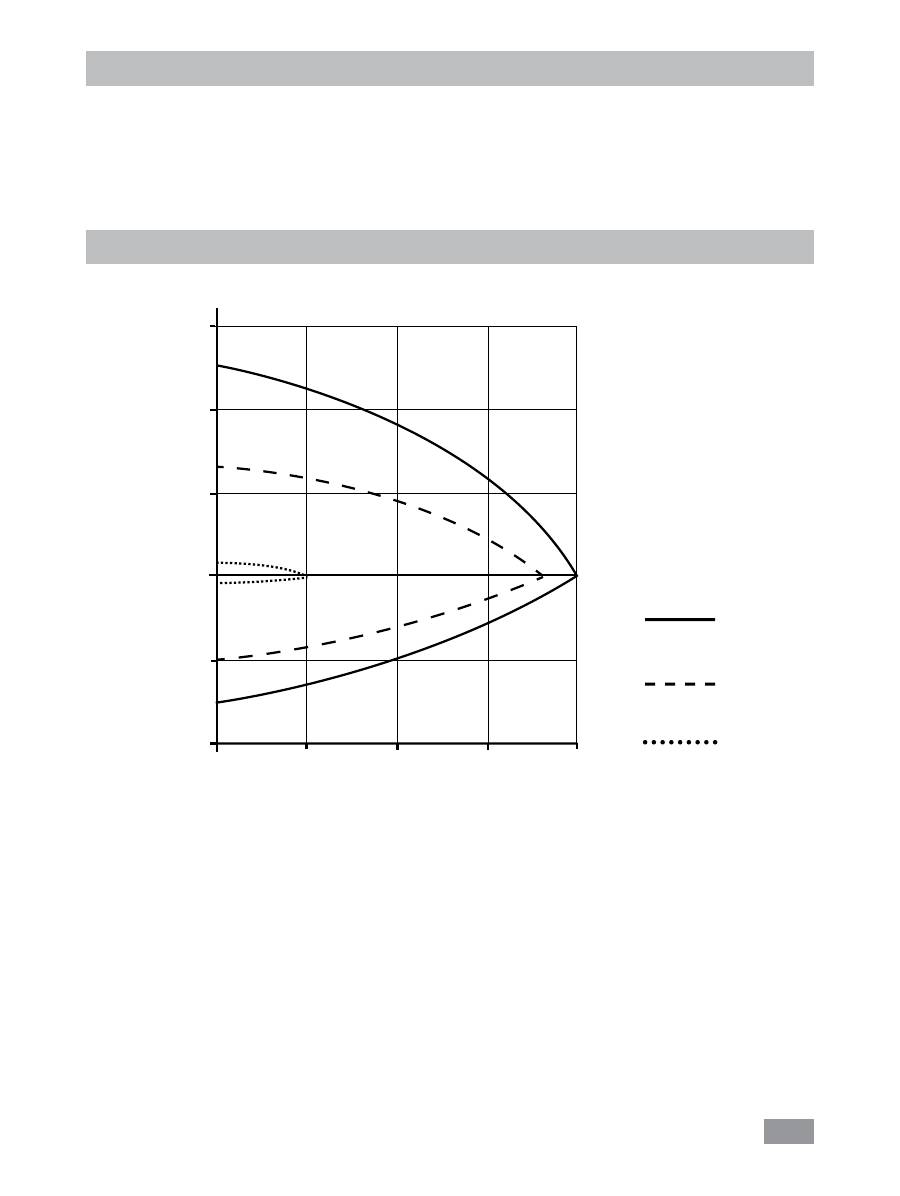
39
Warranty
In accordance with
IKA
®
warranty conditions, the warranty
period is 24 months. For claims under the warranty please
contact your local dealer. You may also send the machine
direct to our factory, enclosing the delivery invoice and giv-
ing reasons for the claim. You will be liable for freight costs.
The warranty does not cover worn out parts, nor does
it apply to faults resulting from improper use, insufficient
care or maintenance not carried out in accordance with
the instructions in this operating manual.
0,6 0,4 0,2 0,0 -0,2 -0,4 0 5 10 15 20 Q [l/min] P [bar]
Pump performance curve
4000 rpm
3000 rpm
1000 rpm
Fig. 18
Pump performance curve measured with water

40
Sommaire
FR
Langue d‘origine: allemand
Page
Déclaration de conformité CE .................................................................................................................41
Explication des symboles ........................................................................................................................41
Consignes de sécurité ..............................................................................................................................42
Consignes générales ...................................................................................................................................... 42
Liquides ......................................................................................................................................................... 43
Utilisation conforme ................................................................................................................................44
Utilisation ..................................................................................................................................................... 44
Zone d’utilisation (uniquement en intérieur) ................................................................................................... 44
Déballage ................................................................................................................................................44
Déballage ...................................................................................................................................................... 44
Contenu de la livraison ................................................................................................................................... 44
Préparatifs ..............................................................................................................................................45
Installatio ....................................................................................................................................................... 45
Raccordement des tuyauteries/flexibles ........................................................................................................... 45
Remplissage et vidage .................................................................................................................................... 45
Liquides ......................................................................................................................................................... 46
Serpentin de refroidissement .......................................................................................................................... 46
Tableau de commande et affichage .........................................................................................................47
Mise en service ........................................................................................................................................48
Réglage de la température de sécurité ....................................................................................................48
Menu «Réglages» ....................................................................................................................................49
Structure des menus ...................................................................................................................................... 49
Informations générales sur le réglage des options de menu ........................................................................... 49
Mode de fonctionnement (MODE) ................................................................................................................. 49
Température maximale (HI T) .......................................................................................................................... 49
Température minimale (LO T) .......................................................................................................................... 49
Vitesse de rotation maximale (HI R) ................................................................................................................ 50
Vitesse de rotation minimale (LO R) ................................................................................................................ 50
Type de liquide (FLUI) ..................................................................................................................................... 50
Type de régulation de température (AUTO) ..................................................................................................... 50
Régulation de température externe et interne (ET) ......................................................................................... 51
Son pour l’alarme et les touches (BEEP) .......................................................................................................... 51
Étalonnage et alignement (CALI) .................................................................................................................... 51
Interfaces et sorties .................................................................................................................................52
Entretien et nettoyage ............................................................................................................................54
Codes d’erreur .........................................................................................................................................55
Accessoires ..............................................................................................................................................56
Caractéristiques techniques .....................................................................................................................57
Garantie ..................................................................................................................................................58
Courbe caractéristique de la pompe ........................................................................................................58

